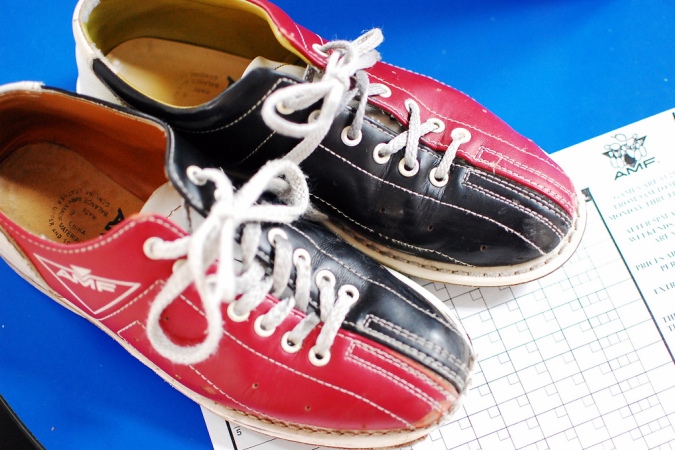What equipment do you need for bowling?

File photo credit: flickr.com/photos/stevensnodgrass
The game of bowling has evolved little since the first ever indoor bowling alley was built in 1840 at Knickerbockers, New York City. The technology and material used may have improved, but the standard equipment required of a player remains the same: a pair of bowling shoes and a bowling ball.
Why Do You Have to Wear Bowling Shoes?
Every bowling alley will insist that you wear a pair of bowling shoes to play. This is mainly for two reasons: safety and performance.
The surface of most bowling alleys is flat, moderately slick and free of debris. Due to the oiling on the lanes, normal shoes may stick to the floor, causing injuries as your built-up momentum quickly brings you to a stop. This kind of accident causes sprained ankles, wrists and backs as well as an array of other injuries.
Bowling shoes also come with special soles, one for sliding, and the other for braking. The sliding shoe features a sole that will allow the bowler to easily slide during their delivery. The braking bowling shoe has a sole, which provides traction, and is usually made of a higher friction material, such as rubber.
People who bowl often might have their own custom bowling shoes for comfort and hygiene, but it is perfectly normal to rent a shoe at the counter for around $1-2.
The Bowling Ball
Like the shoes, a proper bowling ball is required to play the game. Most bowling alleys provide balls for patrons to use within the establishment, often referred to as "house balls."
At a professional level, key properties of bowling balls include surface friction, porosity, and mass distribution, which affect the motion of the ball as it rolls. However most casual bowlers make do with a ball that is simply comfortable and suitable with their finger size.
Other Equipment
Apart from the standard shoes and ball, bowlers have employed different equipment over the years to protect themselves and improve their game. These include:
Wrist guards: The wrist support device will prevent the back of the bowling hand from tilting or collapsing prior to the delivery of the bowling ball. Essentially, the purpose of the device is to limit tilting movement of the wrist, achieving more consistent throws.
Finger Tapes: The friction caused when the fingers release the ball can sometimes cause injuries or scars. That’s why some bowlers now cover their fingers in tape to protect them. Some bowlers also claim that the tape allows them to have better grip on the ball while holding it.
Powder: As your grip plays an important part in holding, swinging and releasing the ball, some players have used powder to reduce moisture in their hands and improve surface grip. Most powders are acceptable, but the most commonly used are baby or talcum powder.
Ankle, Wrist, Elbow Bend: The game’s repetitive nature can cause serious damage to your joints. That’s why some players use gentle shock absorbers to reduce pain and chances of injuries.
Microfibre Cloth/Towel: Many players wipe down their ball after every throw. While part of the reason is psychological, particularly in building a routine, there are also some minor benefits to the action. Wiping down the ball can remove the accumulated oil that has collected on their track. What happens when a bowling ball goes down a lane is that it absorbs some of the oil as it travels toward the pins. Accumulated oil could delay the friction between the bowling ball and the lane, causing the ball to slide forward, rather than spin.
There are of course other equipment used by bowlers, but the most important thing to remember is to look out for your own safety when you throw the ball. Apart from the ball and shoes, the other equipments are mere add-ons that may or may not help your game.
To receive the latest updates on the happenings in the Singapore sports scene, or to find out more about some of the latest programmes on offer at ActiveSG, like our Facebook page here.





![ActiveSG Academies and Clubs Logo (Solid Colour)[8647]](https://www.activesgcircle.gov.sg/hs-fs/hubfs/ActiveSG%20Circle%202023Theme/images/ActiveSG%20Academies%20and%20Clubs%20Logo%20(Solid%20Colour)%5B8647%5D.png?width=150&height=65&name=ActiveSG%20Academies%20and%20Clubs%20Logo%20(Solid%20Colour)%5B8647%5D.png)




-01.png?width=200&height=141&name=Team%20Singapore%20Logo%20(Red)-01.png)



